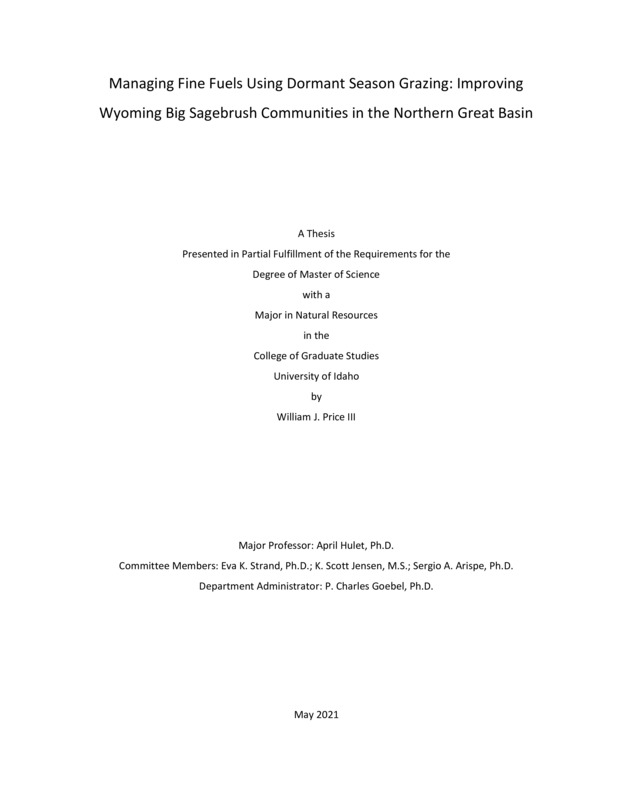Managing Fine Fuels Using Dormant Season Grazing: Improving Wyoming Big Sagebrush Communities in the Northern Great Basin
Price, William J. (2021-05). Managing Fine Fuels Using Dormant Season Grazing: Improving Wyoming Big Sagebrush Communities in the Northern Great Basin. Theses and Dissertations Collection, University of Idaho Library Digital Collections. https://www.lib.uidaho.edu/digital/etd/items/price_idaho_0089n_12078.html
- Title:
- Managing Fine Fuels Using Dormant Season Grazing: Improving Wyoming Big Sagebrush Communities in the Northern Great Basin
- Author:
- Price, William J
- ORCID:
- 0000-0003-3053-6335
- Date:
- 2021-05
- Keywords:
- Fuels reduction Medusahead Targeted Grazing
- Program:
- Natural Resources
- Subject Category:
- Range management; Ecology; Agriculture
- Abstract:
-
The invasive annual grass medusahead infests rangelands throughout the West, from the Columbia Plateau to the California Annual Grasslands and the Great Basin. Dominating secondary succession in the sagebrush steppe, it can create conditions for frequent wildfires that degrade habitat of threatened species, such as the greater sage-grouse. This research explores the potential of dormant season grazing as an applied management strategy to reduce the negative impacts of medusahead while promoting recovery of perennial vegetation at the landscape-scale from 2018-2020. In particular, it assessed grazing with four treatments: traditional grazing (May – October), dormant season grazing (October – February), traditional+dormant season grazing (May – February), and no grazing. After two years of grazing treatments, biomass, density, cover, and fuel continuity did not differ between treatments (p > 0.05). However, biomass measurements were significantly different between years which is likely due to greater than normal precipitation in 2019 and 2020. Between 2018-2019, annual grass biomass increased by 81% (666 – 1,212 kg ha-1) and perennial grass biomass increased by 165% (118 – 313 kg ha-1). Litter biomass decreased by approximately 15% in every year since 2018 (2,374, 2,012, and 1,678 kg ha-1 in 2018 – 2020). There were not significant differences in cover or density of annual and perennial grasses between treatments and years. Our results indicate that two years may not be adequate time for dormant season grazing treatments to be effective in reducing the abundance of medusahead, and that dormant season grazing after two years of treatments does not have a detrimental effect on perennial vegetation.
- Description:
- masters, M.S., Natural Resources -- University of Idaho - College of Graduate Studies, 2021-05
- Major Professor:
- Hulet, April
- Committee:
- Strand, Eva K; Jensen, Scott; Arispe, Sergio A
- Defense Date:
- 2021-05
- Identifier:
- Price_idaho_0089N_12078
- Type:
- Text
- Format Original:
- Format:
- application/pdf
- Rights:
- In Copyright - Educational Use Permitted. For more information, please contact University of Idaho Library Special Collections and Archives Department at libspec@uidaho.edu.
- Standardized Rights:
- http://rightsstatements.org/vocab/InC-EDU/1.0/

